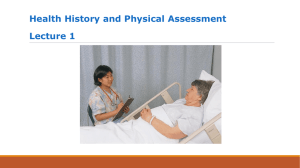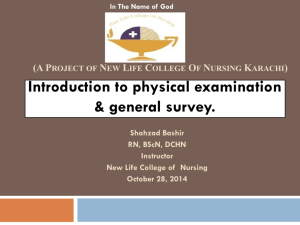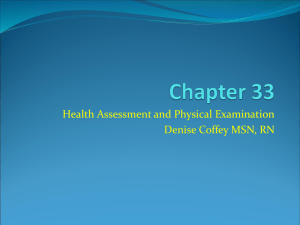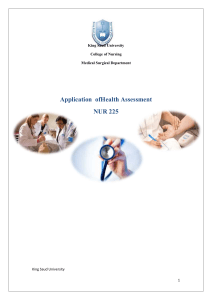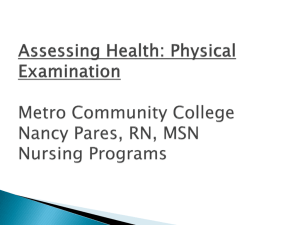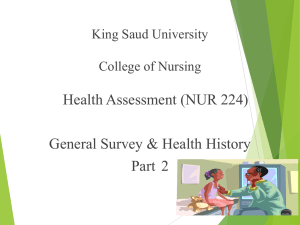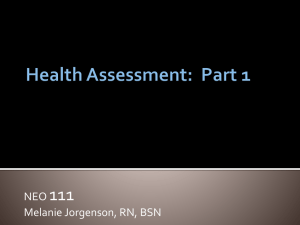The student nurse should be able to
advertisement
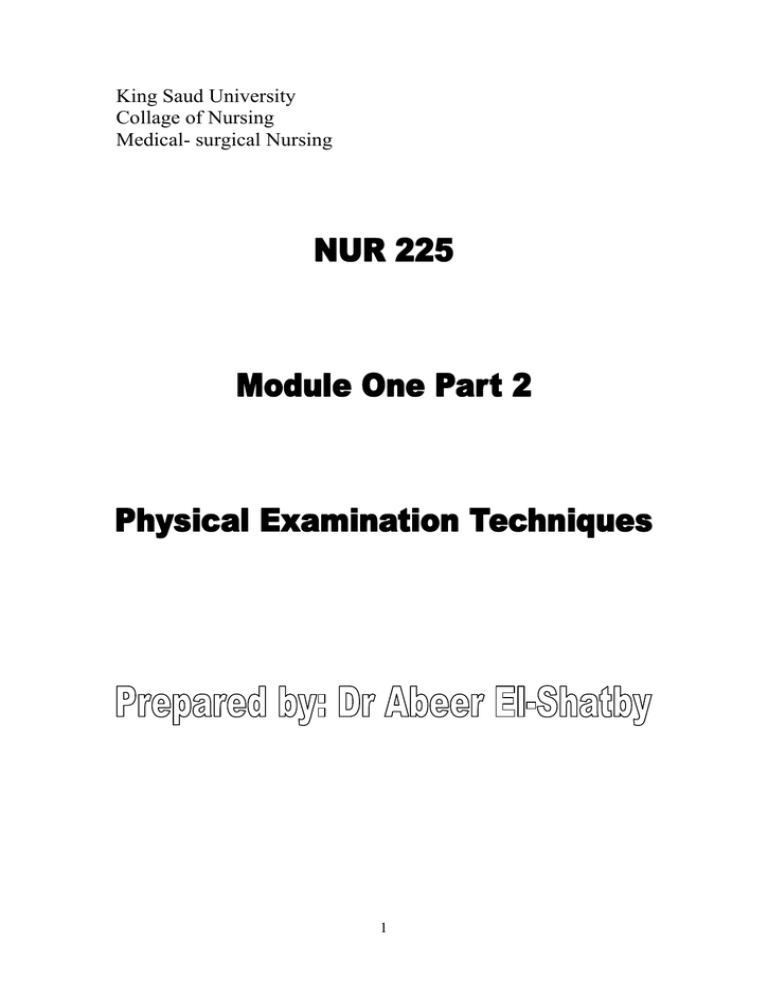
King Saud University Collage of Nursing Medical- surgical Nursing 1 Physical Examination Techniques Procedural Steps: Common tasks performed prior to carrying out the procedural steps of Physical Examination: A-Prepare needed equipment: (Refer to equipment list) B- Patient and environment preparation: Explain procedure to patient Ask patient to undress and drape him / her appropriately Make sure the room is warm, quit , and adequately light Ensure patient privacy Wash hands C- Conduct general survey D- Procedural steps of Physical Examination Techniques: 1-Inspection: Technique Rational 1-Inspection starts at the initial patient encounter 2-Expose area to be inspected, sufficiently. 1-Inspection is the main skill employed in general survey 2- Allows the area to be totally seen 3- Adjust lightning (or use penlight) as needed 4-Use vision and smell senses to observe client 5- Note key landmarks while inspecting the entire body areas 3-Allows all areas’ details to be observed. 4Helps elicit highly sensitive clues about client 5-Ensures accurate descriptions of findings 2 6-Inspect client following body system review 7-Inspect for: Color, odor, sounds, shapes, texture, size, location, movement, odor, and symmetry. 2-Palpation Technique 1-Inform patient to expect occasional discomfort. 2-Ask patient to report pain 3-Warm hands by kneading them together 4-Wear gloves if palpating mucous membrane or other areas involving body fluids 5-Keep tender areas last. 6-Keep observing patients’ face through out the palpation. 7- Apply just enough pressure to assess the tissue beneath one or both hands, then release pressure and gently move to the next area. 8-Move hands systematically Start with light palpation 1-Hold the pads of 2-3 fingers together 2-Press gently on the skin to a depth of 1-2 cm (use lightest touch possible) 3-palpate for; texture, swelling, pulsation, lumps 3 Rational 1-Pressure causes organs discomfort 2- Assess for tenderness. 3- Cold touch causes stiffening and restricts palpation. 4-Prevents infection. 5-Tenderness radiates to surrounding organs causing acute pain ;which aggravates the patient and reduces his / her cooperation 6-Allows detection of sings of pain. 7-Prevents excessive pain or rupture of internal organs. 8-Ensures covering the entire area to be assessed Light palpation detects surface characteristics and accustom patient to being touched. 1-Provide fine tactile discrimination of superficial organs. 2-Deeper pressure blunts examiner fine tactile sensitivity Tenderness, temperature , moist, elasticity. deep palpation Deep palpation is employed to assess deep structures 1-Muscle tension interfere with performance and result of palpation 1-Instruct patient to relax 2-Use finger tips to press skin down 4-5 cm with firm deep pressure 3-May place one hand on top of the palpating hand 4- Palpate for skin texture ,swelling ,pulsation ,lump 4 3-Controls and guides hand movement position ,shape, consistency, mass, size , tenderness, mobility, vibrations 3- Percussion Technique Direct Percussion 1-Instruct patient to tell which areas are painful during test 2-Use one or two fingers 3-tap finger pads directly on body part Rational Direct percussion elicits tenderness and sounds of small body tissues(sinuses, child thorax) 1-to assess for tenderness (pain is a subjective data). 2-It facilitate percussion of small body areas 3-gives the direct response of small tissue under percussion 4-percuss for sound, tenderness Indirect percussion is performed to map ,elicit pain & reflexes ,signals density of organ, and detects superficial mass 1-Press and hyperextend the distal part 1-This finger work as a and joint of middle finger of nondominant mediating device to receive the hand firmly on the body part to be taps(pleximeter) assessed Indirect percussion 5 2-Keep the rest of the nondominant hand 2-Other fingers touching the off the body surface surface will damp the sound 3-Bring the dominant hand wrist over the nondominant hand wrist 4-Flex the dominant hand wrist 4-This keeps the movement at the wrist (not at finger, elbow ,or shoulder) 5-Place the dominant hand forearm close to surface to be perccused 6-Keep dominant hand wrist and forearm 6-This provides the lightest as relaxed as possible touch capable of producing a clear sound 7-With relaxed wrist motion; use the tip of flexed middle finger of dominant hand(plexor) to tap just beneath the distal joint of the middle finger of nondominant hand *perpendicularly (90 degrees angle ) *directly *quickly 6 7-This provides the strongest strike where the greatest pressure is exerted on the surface to be perccused. *don’t tap with finger pads(short nails is a must) 8-Lift the tip of middle finger of dominant hand rapidly between strikes 9-Move nondominant hand to cover the entire area to be percussed 10-Keep consistent degree of firmness exerted by the hyper extended finger while moving from area to area 11-Listen for sounds’: Amplitude: Loudness or intensity of the sound, it ranges from loud, medium loud, soft, to very soft. Quality: type of note that describes the density of the organ that ranges from hollow, fluid, partially dense, to dense 8-Avoids dampening the vibrations 10-Different degrees of firmness cause the sound to vary 4-Auscultation Technique 1-Determine which side of stethoscope to use diaphragm bell 2-Eliminate extraneous sounds by *remove clothes *wet body hair *avoid rubbing head of stethoscope against body surface 3-Disinfect stethoscope *head between patients;& 7 Rational 1-Diaphragm detects highpitched sounds (breath, bowel) Bell detects low-pitched sounds (heart, vessels) 2-The function of stethoscope is to block extraneous sounds and concentrate body sounds, it DOES NOT magnify sounds. 3-Eliminates possible vector infection *earpiece if you use other persons’ stethoscope 4-Warm the stethoscope with your hand 4-Cold stethoscope causes involuntary muscle contractions that draws out other sounds 5-Slope the earpiece in ears such that they 5-This directs sounds towards face towards nose the ear canals 6-Place the head of stethoscope on body area to be assessed *if using diaphragm: hold it firmly To block extraneous sounds enough against the patient’s skin to leave a slight ring afterward *if using bell :hold it lightly against the skin enough to form a seal Holding the bell too firmly causes the skin to act as a diaphragm which obliterates low-pitched sounds 7- May close eyes and listen 7-It helps focusing attention Listen and identify the sound’s: Intensity: strength Pitch: loudness of the peak Duration: length that each sound cycle lingers 8 King Saud University Collage of Nursing NURSING DEPT. Application of Health Assessment NURS 225 Performance checklist Physical Examination Techniques The student nurse should be able to: Performance criteria Competent Technique Trial 1 Preparation: Conduct general survey Review interview note Explain procedure Position and drape patient correctly Ensure adequate light Explain procedure to patient Wash hands Put the patient in sitting position Expose body part to be examined and Drape patient appropriately Compare findings of any side of body to the other Follow the IPPA sequence Inspection Expose body area to be examined sufficiently Inspect for :color ,odor ,sounds ,shapes ,texture ,size , location ,movement ,symmetry Palpation Inform client to expect occasional discomfort Ask client to report pain Warm hands Keep eyes on patients face Cover entire area to be assessed systematically Keep tender areas last Start with light palpation Light palpation Hold the tips of 2-3 fingers together Press gently on the skin to a depth 9 Trial 2 Competency level Not Comment Competent Trial 1 Trial 2 of 1-2 cm Trial 1 Trial 2 Trial 1 Trial 2 Trial 1 Trial 2 Trial 1 Trial 2 Use dorsal part of hand to assess temperature Palpate for: texture, swelling, pulsation ,lumps ,tenderness ,temperature ,moist ,elasticity Deep Palpation Instruct patient to relax Press down 4-5 cm with the finger tips of both hands Place one hand on top of other if needed Direct Percussion Instruct patient to tell which areas are painful during test Use one or two fingers Tap finger pads directly on body part Percuss for :Sound ,Tenderness Indirect percussion Press and hyperextend the distal part and joint of middle finger of nondominant hand firmly on the body part to be assessed Keep the rest of the nondominant hand off the body surface Bring the dominant hand wrist over the nondominant hand wrist Flex the dominant hand wrist Place the dominant hand forearm close to surface to be percussed Use the tip of flex middle finger of dominant hand to tap beneath the distal joint of the middle finger of nondominant hand *perpendicularly *directly *quickly Lift the tip of middle finger of dominant hand rapidly between strikes Move nondominant hand to cover the entire area to be percussed Keep consistent degree of firmness exerted by the hyper extended finger while moving from area to area Listen for sounds’: Amplitude , Quality 10 Auscultation Disinfect stethoscope Eliminate extraneous sounds Warm the stethoscope with hand Slope the earpiece in ears facing towards nose Place the head of stethoscope on body area to be assessed using diaphragm: hold it firmly enough against the patient’s skin to leave a slight ring afterward Place the head of stethoscope on body area to be assessed using bell :hold it lightly against the skin enough to form a seal Listen and identify the sound’s Intensity ,Pitch ,Duration 11 Physical examination documentation format Instructions: follow general survey& put a mark at the term that describes your client, and specify when indicated. I. PHYSICAL APPEARANCE 1-Age: the person appears _his or her stated age. _ older, _smaller, _younger 2-:Sexual development _ is appropriate for gender _ is appropriate for age _ shows delayed puberty _ shows early puberty _ is inappropriate to gender 3-Level of consciousness : the person _alert _ oriented _ attends to questions _ responds appropriately _ Confused _drowsy _ Lethargic. 4-Skin : _even color _ intact _ Pallor _cyanosis _ jaundice _lesions--------------------5-Facial features: _ symmetric with movement _. Immobile _ mask like _ asymmetric _ drooping. 6- signs of acute distress:_ Not present _ Shortness of breath _ wheezing _ facial grimace _ holding body part-----------_others--------II. BODY STRUCTURE 1-Stature 2-Nutritional status: – normal –normal _ Excessively short _ Excessively tall _Cachectic, _emaciate_ Obese. 3-Symmetry: body parts look _normal _ Unilateral atrophy _ Unilateral hypertrophy _Asymmetrically located. 4-Posture: –erect _ moves as one unit _Stiff _tense _ deflated. 5-Position: the person _sits comfortable _ Leans forward arms braced on chair arms _Sits straight up _ resists lying down _Curled up in fetal position. 6-Body build, contour: _Elongated arm span _Trunk taller than lower extremities _ Trunk shorter than lower extremities. 7-Physical deformities :– Absent _Present----------------- _ III. MOBILITY 1-Gait: – normal _ stumbling _Shuffling _Limping with injury------------2-Range of motion : _normal _ Paralysis 3-Involuntary movement: _ absent _ Exceptionally wide base _Staggered _ dragging _non-functional limb -----------_Propulsion. _ Limited joint range of motion --------------------. _ uncoordinated movement _ Tics _ tremors _ seizures IV. BEHAVIOR 1-Facial expression: – normal _Flat _ depressed _ angry _sad _ anxious 2-Mood and affect: the person appears –comfortable _ cooperative _ Hostile _ distrustful _ suspicious _ crying 3-Speech: –normal _ Dysarthria _ dysphagia _ monotone _ garbled _talks few words _ Constant talking. 4-Dress: –appropriate _ inappropriate 5-Personal hygiene: ––appropriate _ inappropriate 12 King Saud University Collage of Nursing Medical- surgical Nursing Application of Health Assessment NURS 225 Performance checklist General Survey The student nurse should be able to: Performance Criteria Collects General Survey data related to: I. PHYSICAL APPEARANCE Competency level Competent TRIAL 1 Not Competent TRIAL 2 1. Age. 2.Sex 3.Level of consciousness 4.Skin color 5.Facial features 6. Acute distress Signs. II. BODY STRUCTURE 1.Stature 2.Nutritional status 3.Symmetry 4.Posture 5.Position 6. Body build, contour. 7.Physical deformities III. MOBILITY 1.Gait 2. Range of motion. 3.Involuntary movement IV. BEHAVIOR 1.Facial expression 2.Mood and affect 3.Speech 4.Dress 5.Personal hygiene Document General Survey data according to designated format. 13 TRIAL 1 Comment TRIAL 2 Choose the correct answer for each of the following questions: 1. Physical examination should be conducted systematically, means that it is a. Right to left examination b. Head to toe examination c. Left to right examination d. Toe to head examination 2. All examination techniques may involve the use of equipment EXCEPT: a. inspection b. palpation c. percussion d. Auscultation 3. The sequence of the four examination techniques is. a. Inspection, percussion, palpation, auscultation b. Inspection, palpation, percussion, auscultation c. Auscultation, palpation, percussion, inspection d. percussion, palpation, auscultation , inspection 4. Tender areas examination should be kept till end of examination during: a. Inspection b. Palpation c. Percussion d. Auscultation 5. The diaphragm of the stethoscope is used to auscultate : a. High –pitched sound b. Low _pitched sound c . Medium_pitched sound d. No –pitched sound 6. In percussion technique the nondominant hand should be kept : a. off the body surface b. directly on the body surface c. perpendicular to the body surface d. All the above 7. During palpation the examiners eyes should be focused on: a. The clients face b .Body part being palpated c. The examiners hands d. None of the above 14 Nutrition Screening Patient Interview Form Instructions: Circle or fill in the blanks with actual physical assessment findings. Steps rational *A-Triceps skin fold thickness (TSF):-1-Find the midpoint circumference of the arm by 1. to perfect measurement placing the tap measure halfway between the axilla and elbow. 2-Grasp a fold of skin and fat on the posterior 2. to grasp fat not muscle aspect of the patient `s left arm with your thumb and forefinger about 1cm above the midpoint 3-Repeat three times and average the three skin 3. to validate measurement fold measurement 4-Record the measurement to the nearest 4. as standard normal millimeter. 5-Compare the patient’s measurement with 5. to detect deviation from normal standard. *B-Mid upper arm circumference 1-Measure the midarm circumference by placing the tap horizontally at midpoint ,then tighten it 1. to perfect measurement and to avoid firmly around the arm . as shown in picture 3. compression the soft tissue 2-Recod the measurement in centimeters. 3-Compare the finding with standard. 2.as standard normal 3. to detect deviation from normal 15 Nutrition Screening Patient Interview Form Instructions: Circle or fill in the blanks with actual physical assessment findings WNL=Within Normal Limits for age. Mark items which require additional documentation with an asterisk (*) and document in the Nurse’s Notes sections of the Daily Nurses Record. Pt. Identification data Name-------------Age----- Sex----- occupation ----------- Marital status---------Tel/Address---------------------- Known Allergies--------------------------------- General Survey Physical appearance _ WNL, abnormality----------------- Body structure _WNL, abnormality--------------Mobility _WNL, abnormality------------------------ Behavior _ WNL, abnormality--------- Present history Chief complaint: P------------------------------------------------- P -----------------------------------Q------------------------------------------------ R------------------------------------------- R-------------S------------------------------------------------ T------------------------------------------Associated symptoms -------------------------------Medication ------------------------------------ ----------------------------------------------------------Past history-----------------------------------------------------------------------------------------------------------------------------------------------------------------------------------------------------------------Family) history------------------------------------------------------------------------------------------------------------------------------------------------------------------------------------------------------------Check if person is experiencing any of the following problems;÷ Reduce food intake by 1/2 in 3days ÷ recent weight loss ÷ Recent weight gain. ÷ Diabetes /renal disease /liver disease, other…………….. Appetite. ÷ Good ÷ fair ÷ bad ÷ Difficulty chewing /swallowing ÷ Vomiting ÷ Diarrhea ÷ Constipation ÷ Regular diet ÷ Especial diet .what type --------------? ÷ medications. What type? --------------Frequency? /duration of use? ÷ Substance abuse. What type? --------------Frequency? Duration of use? -----------÷ pregnancy/ lactation Anthropometric measurement ÷ body mass index………………………. ÷ Triceps skin fold index……………….. ÷ mid upper arm circumference…………………. 16 King Saud University College of Nursing Medical-Surgical Department Application of Health Assessment NUR 225 Performance checklist Nutritional assessment The student nurse should be able to Performance Criteria Competency level Competent Not Competent Trial 1 Trial 2 Trial 1 Trial 2 *Collect appropriate subjective data related to nutritional history. *Prepare required equipment. *Explain procedure to the patient. *Perform anthropometric measurement A. Triceps skin fold thickness (TSF ) B. Mid upper arm circumference (MAC) c.Body Mass Index (BMI) *Document finding following designated Format. Instructor signature: ----------------------- 17 comment
